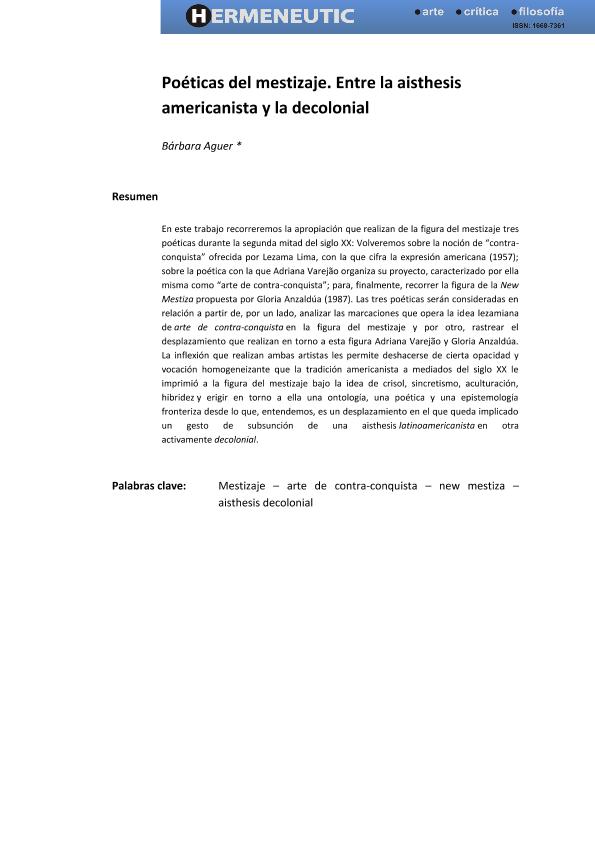Artículo
En este trabajo recorreremos la apropiación que realizan de la figura del mestizaje tres poéticas durante la segunda mitad del siglo XX: Volveremos sobre la noción de “contraconquista” ofrecida por Lezama Lima, con la que cifra la expresión americana (1957); sobre la poética con la que Adriana Varejão organiza su proyecto, caracterizado por ella misma como “arte de contra-conquista”; para, finalmente, recorrer la figura de la New Mestiza propuesta por Gloria Anzaldúa (1987). Las tres poéticas serán consideradas en relación a partir de, por un lado, analizar las marcaciones que opera la idea lezamiana de arte de contra-conquista en la figura del mestizaje y por otro, rastrear el desplazamiento que realizan en torno a esta figura Adriana Varejão y Gloria Anzaldúa. La inflexión que realizan ambas artistas les permite deshacerse de cierta opacidad y vocación homogeneizante que la tradición americanista a mediados del siglo XX le imprimió a la figura del mestizaje bajo la idea de crisol, sincretismo, aculturación, hibridez y erigir en torno a ella una ontología, una poética y una epistemología fronteriza desde lo que, entendemos, es un desplazamiento en el que queda implicado un gesto de subsunción de una aisthesis latinoamericanista en otra activamente decolonial. In this work we will go through the appropriation that three poetics make of the figure of miscegenation during the second half of the 20th century: We will return to the notion of "counter-conquest" offered by Lezama Lima, with which he figures the American expression (1957); about the poetics with which Adriana Varejão organizes her project, characterized by herself as "art of counter-conquest"; to finally go through the figure of the New Mestiza proposed by Gloria Anzaldúa (1987). The three poetics will be considered in relation to, on the one hand, analyzing the markings that the Lezamian idea of counter-conquest art operates in the figure of miscegenation and, on the other, tracing the displacement they make around this figure Adriana Varejão and Gloria Anzaldúa. The inflection carried out by both artists allows them to get rid of a certain opacity and homogenizing vocation that the Americanist tradition in the middle of the 20th century imprinted on the figure of miscegenation under the idea of melting pot, syncretism, acculturation, hybridity and to erect an ontology around it. , a poetics and a border epistemology from what, we understand, is a displacement in which a gesture of subsumption of a Latin Americanist aisthesis in another actively decolonial is implied.
Poéticas del mestizaje: Entre la aisthesis americanista y la decolonial
Título:
Poetics of miscegenation: Between the Americanist and the decolonial aisthesis
Fecha de publicación:
11/2020
Editorial:
Universidad Nacional de la Patagonia Austral
Revista:
Hermeneutic
ISSN:
1668-7361
Idioma:
Español
Tipo de recurso:
Artículo publicado
Clasificación temática:
Resumen
Palabras clave:
MESTIZAJE
,
ARTE DE CONTRA CONQUISTA
,
NEW MESTIZA
,
AISTHESIS DECOLONIAL
Archivos asociados
Licencia
Identificadores
Colecciones
Articulos(SEDE CENTRAL)
Articulos de SEDE CENTRAL
Articulos de SEDE CENTRAL
Citación
Aguer, Bárbara; Poéticas del mestizaje: Entre la aisthesis americanista y la decolonial; Universidad Nacional de la Patagonia Austral; Hermeneutic; 18; 11-2020; 83-102
Compartir




